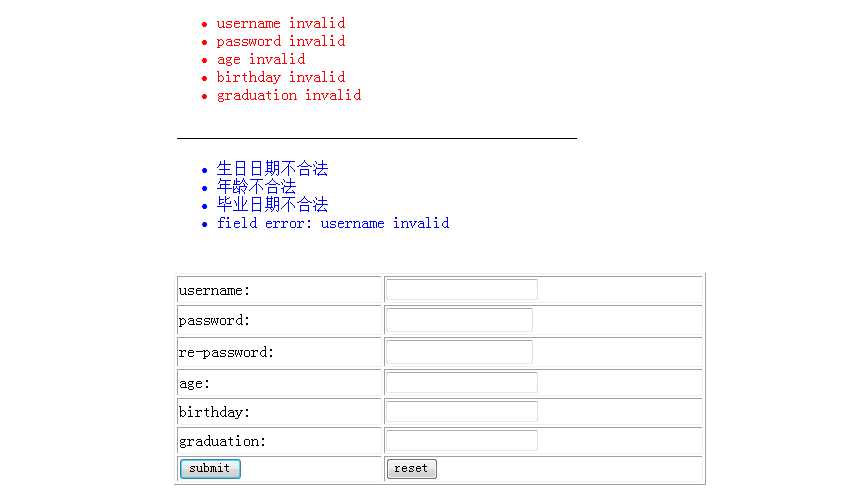标签:
下面提供一个输入校验的一个实例,递进式学习:
首先,建立输入页面:register.jsp:
<%@ page language="java" import="java.util.*" pageEncoding="GBK"%>
<%@ taglib uri="/struts-tags" prefix="s" %>
<%
String path = request.getContextPath();
String basePath = request.getScheme()+"://"+request.getServerName()+":"+request.getServerPort()+path+"/";
%>
<!DOCTYPE HTML PUBLIC "-//W3C//DTD HTML 4.01 Transitional//EN">
<html>
<head>
<base href="<%=basePath%>">
<title>My JSP ‘register.jsp‘ starting page</title>
<meta http-equiv="pragma" content="no-cache">
<meta http-equiv="cache-control" content="no-cache">
<meta http-equiv="expires" content="0">
<meta http-equiv="keywords" content="keyword1,keyword2,keyword3">
<meta http-equiv="description" content="This is my page">
<!--
<link rel="stylesheet" type="text/css" href="styles.css">
-->
</head>
<body>
<table align="center" width="40%" border="0">
<tr>
<td>
<s:actionerror cssStyle="color:red"/><%--actionerror中增加的所有信息显示到页面上 --%>
__________________________________________________
<s:fielderror cssStyle="color:blue"></s:fielderror>
</td>
</tr>
</table>
<form action="register.action" method="post">
<table align="center" width="40%" border=1">
<tr>
<td>
username:
</td>
<td>
<input type="text" name="username" size="20">
</td>
</tr>
<tr>
<td>
password:
</td>
<td>
<input type="password" name="password" size="20">
</td>
</tr>
<tr>
<td>
re-password:
</td>
<td>
<input type="password" name="repassword" size="20">
</td>
</tr>
<tr>
<td>
age:
</td>
<td>
<input type="text" name="age" size="20">
</td>
</tr>
<tr>
<td>
birthday:
</td>
<td>
<input type="text" name="birthday" size="20">
</td>
</tr>
<tr>
<td>
graduation:
</td>
<td>
<input type="text" name="graduation" size="20">
</td>
</tr>
<tr>
<td>
<input type="submit" value="submit"/>
</td>
<td>
<input type="reset" value="reset"/>
</td>
</tr>
</table>
</form>
</body>
</html>
接着建立处理类RegisterAction:
package com.test.action;
import java.util.Calendar;
import java.util.Date;
import com.opensymphony.xwork2.ActionSupport;
public class RegisterAction extends ActionSupport
{
private String username;
private String password;
private String repassword;
private int age;
private Date birthday;
private Date graduation;
public String getUsername()
{
return username;
}
public void setUsername(String username)
{
this.username = username;
}
public String getPassword()
{
return password;
}
public void setPassword(String password)
{
this.password = password;
}
public String getRepassword()
{
return repassword;
}
public void setRepassword(String repassword)
{
this.repassword = repassword;
}
public int getAge()
{
return age;
}
public void setAge(int age)
{
this.age = age;
}
public Date getBirthday()
{
return birthday;
}
public void setBirthday(Date birthday)
{
this.birthday = birthday;
}
public Date getGraduation()
{
return graduation;
}
public void setGraduation(Date graduation)
{
this.graduation = graduation;
}
@Override
public String execute() throws Exception
{
System.out.println("execute invoked");
return SUCCESS;
}
public String test() throws Exception
{
System.out.println("test invoked");
return SUCCESS;
}
public void validateTest()
{
}
@Override
public void validate()
{
System.out.println("validate~~~~~~~~~~~~~~~~");
if(null == username || username.length() < 6 || username.length() > 10)
{
// 进行错误消息输出
this.addActionError("username invalid");
this.addFieldError("username", "field error: username invalid");
}
if(null == password || password.length() < 6 || password.length() > 10)
{
this.addActionError("password invalid");
}
else if(null == repassword || repassword.length() < 6 || repassword.length() > 10)
{
this.addActionError("repassword invalid");
}
else if(!password.equals(repassword))
{
this.addActionError("two passwords not the same");
}
if(age < 1 || age > 150)
{
this.addActionError("age invalid");
// this.addFieldError("age", "field error: age invalid");
}
if(null == birthday)
{
this.addActionError("birthday invalid");
}
if(null == graduation)
{
this.addActionError("graduation invalid");
}
if(null != birthday && null != graduation) // 可以不写,因为前面验证通过了
{
Calendar c1 = Calendar.getInstance();
c1.setTime(birthday);
Calendar c2 = Calendar.getInstance();
c2.setTime(graduation);
if(!c1.before(c2))
{
this.addActionError("birthday should be before graduation");
}
}
}
}
success.jsp如下:
<%@ page language="java" import="java.util.*" pageEncoding="ISO-8859-1"%>
<%
String path = request.getContextPath();
String basePath = request.getScheme()+"://"+request.getServerName()+":"+request.getServerPort()+path+"/";
%>
<!DOCTYPE HTML PUBLIC "-//W3C//DTD HTML 4.01 Transitional//EN">
<html>
<head>
<base href="<%=basePath%>">
<title>My JSP ‘success.jsp‘ starting page</title>
<meta http-equiv="pragma" content="no-cache">
<meta http-equiv="cache-control" content="no-cache">
<meta http-equiv="expires" content="0">
<meta http-equiv="keywords" content="keyword1,keyword2,keyword3">
<meta http-equiv="description" content="This is my page">
<!--
<link rel="stylesheet" type="text/css" href="styles.css">
-->
</head>
<body>
<table align="center" width="40%" border=1">
<tr>
<td>
username:
</td>
<td>
${requestScope.username }
</td>
</tr>
<tr>
<td>
password:
</td>
<td>
${requestScope.password }
</td>
</tr>
<tr>
<td>
age:
</td>
<td>
${requestScope.age }
</td>
</tr>
<tr>
<td>
birthday:
</td>
<td>
${requestScope.birthday }
</td>
</tr>
<tr>
<td>
graduation:
</td>
<td>
${requestScope.graduation }
</td>
</tr>
</table>
</body>
</html>
web.xml文件配置如下:
<?xml version="1.0" encoding="UTF-8"?> <web-app version="2.5" xmlns="http://java.sun.com/xml/ns/javaee" xmlns:xsi="http://www.w3.org/2001/XMLSchema-instance" xsi:schemaLocation="http://java.sun.com/xml/ns/javaee http://java.sun.com/xml/ns/javaee/web-app_2_5.xsd"> <filter> <filter-name>struts2</filter-name> <filter-class> org.apache.struts2.dispatcher.ng.filter.StrutsPrepareAndExecuteFilter </filter-class> </filter> <filter-mapping> <filter-name>struts2</filter-name> <url-pattern>/*</url-pattern> </filter-mapping> </web-app>
struts.xml配置如下:
<?xml version="1.0" encoding="UTF-8" ?>
<!DOCTYPE struts PUBLIC
"-//Apache Software Foundation//DTD Struts Configuration 2.0//EN"
"http://struts.apache.org/dtds/struts-2.0.dtd">
<struts>
<package name="struts2" extends="struts-default">
<action name="helloworld" class="com.test.action.HelloWorld">
<result name="success">/helloworld.jsp</result>
</action>
<action name="login" class="com.test.action.LoginAction">
<result name="success">/result.jsp</result>
</action>
<action name="converterAction" class="com.test.action.PointAction" method="test">
<result name="success">/output.jsp</result>
</action>
<action name="register" class="com.test.action.RegisterAction" method="test">
<result name="success">/success.jsp</result>
<result name="input">/register.jsp</result>
</action>
</package>
</struts>
为了实现本地化,在RegisterAction.java所在的包com.test.action下新建一个RegisterAction.properties文件,通过Add的方式添加以下内容:

访问http://localhost:8080/struts2/register.jsp,这里是一个输出案例:

这里需要注意的几点:校验方法中自己定义的校验方法首先执行,最后执行validate方法;Action级别的消息struts是不会帮助我们自动生成的,而field级别的错误消息会帮助我们生成,同时还可以写自己的错误消息,这是field级别的struts定义的和字节定义的消息都会输出;为了在页面上输出信息,需要在form表单上面添加类似下面这样的信息:
<s:actionerror cssStyle="color:red"/><%--actionerror中增加的所有信息显示到页面上 --%>
<s:fielderror cssStyle="color:blue"></s:fielderror>
标签:
原文地址:http://www.cnblogs.com/Code-Rush/p/4662751.html